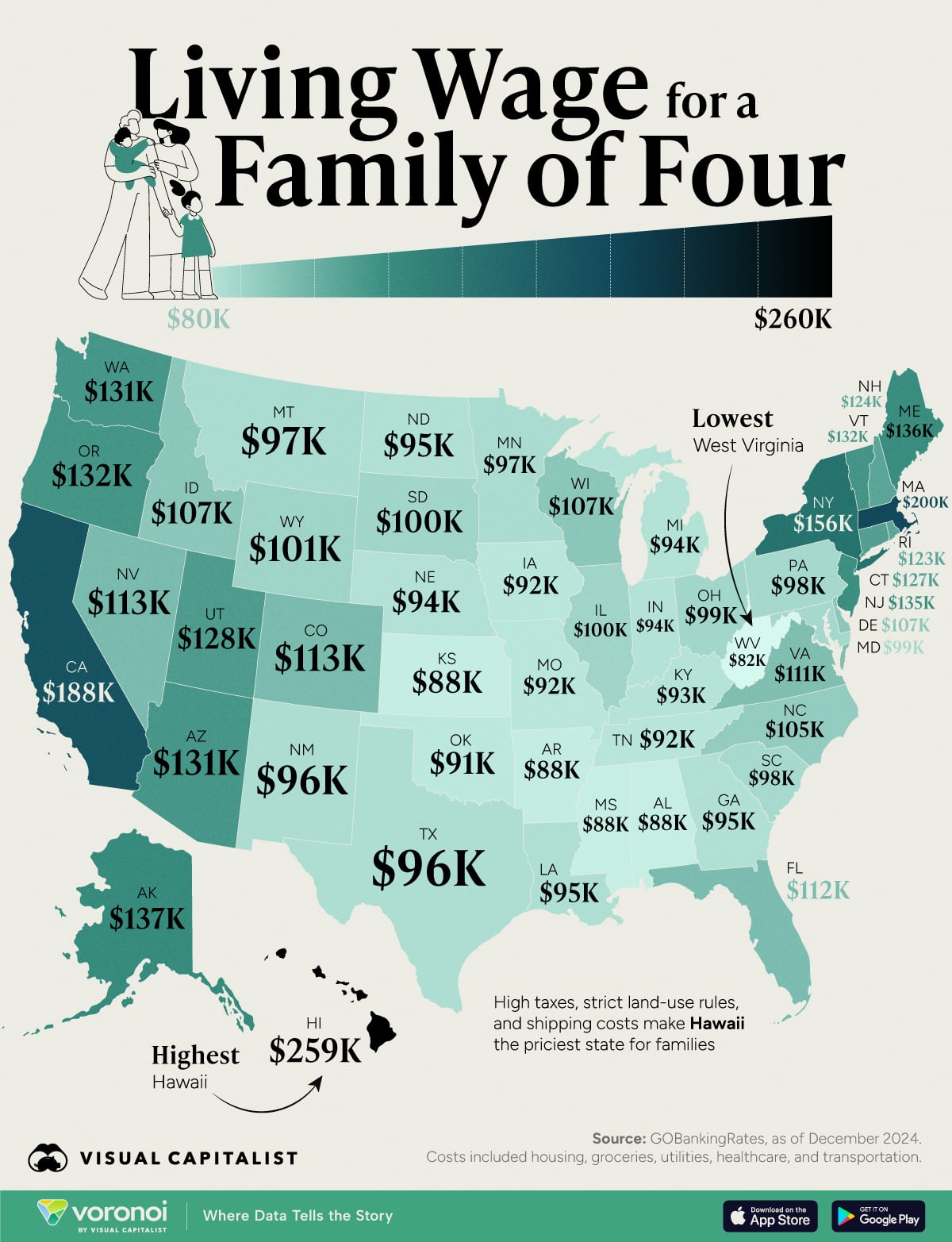TL;DR – Listen to the article post:
Almost every Monday, I log in to my LinkedIn account and peruse for about 15 minutes to see what people are up to and if there’s any useful information I can glean.
How often do I actually find helpful information that benefits my life? Maybe once a year. Does that fact stop me from doing my weekly perusing? Nope.
But this past week, I did see a really nice-looking graphic making the rounds. Using data from a GOBankingRates survey, Voronoi put together a map showing how much money a family of four would need to earn for a “living wage” in each state:

Hawaii comes in as the highest cost-of-living state at $269,000 per year, while West Virginia brings up the rear at $82,000. Smack dab in the middle is South Dakota at $100,000.
As you can imagine, people had some thoughts. One particular post I saw had hundreds of comments, mostly people complaining about the accuracy of the data. Here were a couple of my favorites:
“It’s $112k for a coffee and to breathe in South Florida.”
“Family of four, if you’re single and the other 3 members are a couple of plants and a cat.”
“Let me smack you upside the head with reality here. $124,400 is considered LOW INCOME in New York for a family of four.”
On the other hand, there were plenty of people stating the numbers are inflated:
“Yep, family of 9 here – let’s just say I’m south of $80k and we are doing just fine.”
“As the sole earner of a family of four. This number is very high, but I’d love to see the types of expenses they consider necessities that feed this number.”
“As a father of two who’s lived in both Idaho and Washington these numbers are way too high. A family of 4 can live on $75,000 in Seattle and still build up savings.”
And of course, there was the obligatory political comment:
“Summary: It costs a lot to live in a blue state.”
According to GOBankingRates, they used the 50/30/20 budget rule, which states 50% of your income should go toward necessities, 30% to discretionary spending, and 20% to savings. So, they looked at how much housing, groceries, utilities, healthcare, and transportation cost per year in each state and doubled that to arrive at the “living wage” needed.
My issue with these broad aggregations of data is, as the LinkedIn comments illustrate, if you asked 100 people what they think an appropriate “living wage” you would get 100 different answers.
Why? Because personal finance is personal. We all have different wants, needs, goals, and situations.
Some people have to include student loan payments in their budget, while others had parents who saved to pay for their tuition.
One person could have a 3% mortgage rate on their house while their neighbor has a 7% mortgage rate.
Some people may have chronic health issues that require thousands in healthcare bills each year, while others haven’t been to a hospital since they were born.
One household could have a massive grocery bill due to raising multiple teenage kids, while a different household may only have two adults who have lunch paid for by their employers.
Some people consider charitable giving an indispensable part of their annual budget.
Some people may have family obligations where they’re taking care of aging parents or family members.
Because everyone’s expenses and circumstances are so varied, trying to determine an income that satisfies everyone would be futile. In that sense, the above data has no real practical value, but it does a great job of stirring up online discourse.
I did like the one comment I saw way down at the bottom of the comment section:
“Nothing makes happy people unhappy faster than learning what their neighbors earn.”
The only way to win the social comparison game is not to play. Which, I admit, is easier said than done. Building wealth isn’t a competition, it’s a personal journey. The secret is knowing how much is enough for you, even if it may seem like less than those around you.
Thanks for reading!

Jake Elm, CFP® is a financial advisor at Dentist Advisors. Jake a graduate of Utah Valley University’s nationally ranked Personal Financial Planning program. As a financial advisor at Dentist Advisors, he provides dentists with fiduciary guidance related to investments, debt, savings, taxes, and insurance. Learn more about Jake.</em

